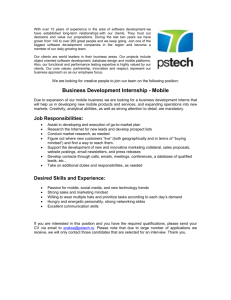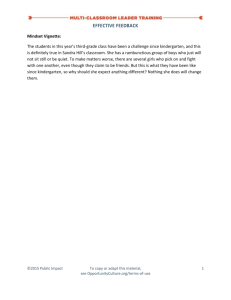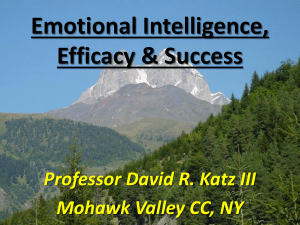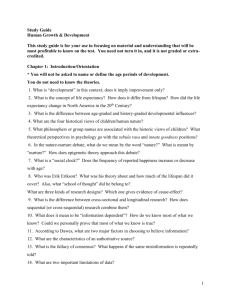Presentation Title to Client*s name Client*s company Day
advertisement
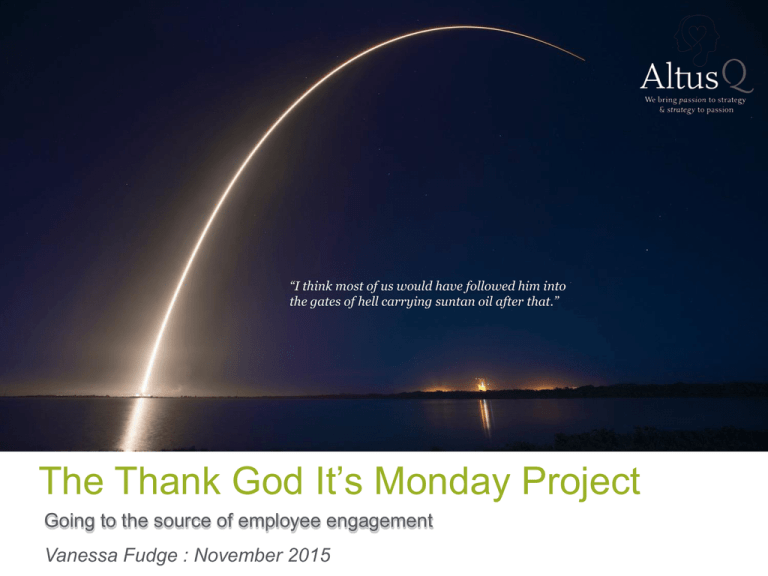
“I think most of us would have followed him into the gates of hell carrying suntan oil after that.” The Thank God It’s Monday Project Going to the source of employee engagement Vanessa Fudge : November 2015 Agenda o Who we are o About the Thank God It’s Monday project o Employee Engagement 101 o However… o Step back and look up o A real-world example o Next steps and an invitation. Who we are (and why we’re worth listening to) o We’re experienced o We’re hands-on and live in the real world o We’ve done our research. Slide 4 About the Thank God It’s Monday project TGIM is a five-year research project aimed at uncovering just what it takes to create a business that employees love to work for. What is Engagement? The ROI of a highly engaged team In a study of 50,000 employees worldwide the Corporate Leadership Council found: • Engaged companies grow profits as much as 3X faster than their competitors • Highly engaged employees are 87 percent less likely to leave the organization. Discretionary Effort Engagement mix Intent to stay Worst case… Leading indicators for engagement The correlations are real and important Over years of surveys and thousands of responses we can confidently say that businesses with strong organisational skillsets tend to have higher engagement scores: Organisations with these skillset scores: Typically have these engagement % scores: In the 70’s 80+ In the 60’s 60-80 In the 50’s 40-60 In the 40’s / low 50’s Below 40 * Capability Score out of a possible 100 points Some skills matter more than others o What are highly engaged organisations focusing on? o o o o o Culture KPIs, Reward & Recognition Performance Management Purpose Recruitment However…let’s talk for a minute about some awkward truths • Spending on employee engagement is now on the order of $1 billion annually in the USA alone. What do we have to show for it? • Are we just making the “stayers” happier while our “achievers” go elsewhere? • Correlation is not causation • The numbers don’t add up. Something is not quite right… According to a recent Gallup poll: • Only 30% of workers are engaged • Only 35% of managers are engaged • 51% of managers are not engaged • 14% are actively disengaged. To put it another way, after years of widespread focus on employee engagement two out of three employees are still functionally zombies - and this is not surprising because half of them are being led by zombies (even if they pretend otherwise to keep their paycheck). Maybe we’re not looking in the right place… Leadership mindset is the leading, leading indicator Leadership Mindset Organisational Skillset Employee Engagement Mental Models – Reactive Signs of a Reactive mindset Leaders who: o Have unrealistic expectations and push too hard for perfect outcomes o Are not happy unless things are done their way o Seek to please others and gain approval rather than risking transformational change o Are too conservative and wishy-washy with decision making o Are emotionally distant and ego driven. Mental Models - Creative Signs of a creative mindset Leaders who: o Foster warm and caring relationships o Take time to connect with people o Lead in a manner that is aligned with your values o Are courageous and speak out directly even on controversial issues o Tend to see the positive side, even in the worst situations o Get the job done without the need to draw attention to themselves and their contribution. Our research has demonstrated a strong relationship between leadership mindset and employee engagement levels Behavior prevalence (100 = “always present”) 70 60 50 40 Perceived creative leadership 30 Perceived reactive leadership 20 10 0 High engagement companies Low engagement companies Other research broadly confirms our premise Belief in leaders makes a huge difference • Where Australian employees perceive both their leader and manager as being effective, 72% are highly engaged and just 3% are disengaged. • Where they perceive both their leader and manager as being ineffective just 8% of these employees are highly engaged while the majority (56%) are disengaged. • Only 44% of Australian employees say their senior leaders are effective. Making great leaders – Creative Mindset Reactive Creative Leadership Energy Achievement Inspiration Control Dependence Task Relate Experiencing the Difference o When did you play it safe? o What did it feel like? o What were the outcomes? o What were the consequences? o Were you creating or reacting? o When did you play it brave? o What did it feel like? o What were the outcomes? o What were the consequences? o Were you creating or reacting? Designing a leadership program to impact Mindset What is the change that people are passionate about? And what is the mindset shift needed to bring it to life? Designing a leadership program to impact Mindset • Don’t be wishy-washy – nail your vision first and measure how your leadership program progresses you toward that vision • Integrate – your leadership program needs to be a facet of your organisational strategy • Leadership is core – so you can’t afford to remain dependent upon external providers for your leadership development. You may need external help to start with but eventually all the skills need to come in-house • A multi-dimensional approach works best – training, coaching, diagnostic, mentoring • Include a giving back component • You will need both courage and persistence – changing how you think requires looking in the mirror, beyond a blind-spot. Example: NSW Institute of Sport (NSWIS) Our Approach 1. Develop the Corporate Plan 2. Then design the leadership program to fit the Plan 3. Develop leadership workshops targeted at the required mindset/behavioral changes 4. Make the program scalable and sustainable by coaching the coaches 5. Embed the cultural and mindset changes via mentoring 6. Extend the framework to strategic partners (in this case Rowing, Swimming, Hockey, ClubsNSW) Leadership modules The individual modules selected for NSWIS were similar to the following: Phase One: – Continuous Improvement – Coaching & Developing Others – Aligning Performance for Success – Planning and Organising – Gaining Commitment. Phase Two: – Building Trusting Relationships – Leading High Performance Teams – Innovation – Building Strategic Relationships – Marshalling Resources. Next steps o Take the capability survey back to work with you o Take the mindset survey next - http://www.altusq.com.au/employeeengagement/the-leadership-mindset-survey/ o Altusq.com.au - engagement research reports OR o Our leadership mindset programs. “Many of the individuals are not used to looking at themselves in the mirror and the concept of leadership has been very hierarchical/power driven – a thing you do to people, rather than QLead's collaborative, self-empowering framework of leadership as a skill to help people become better..…” Leadership is not a position or a title, it is action and example.
